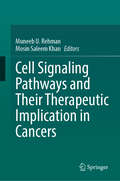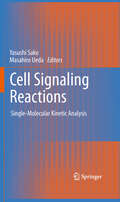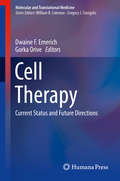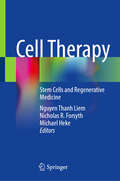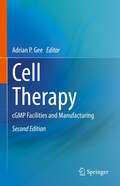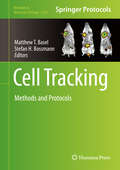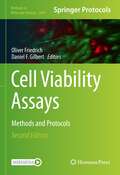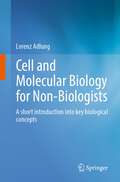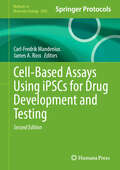- Table View
- List View
Cell Signaling Pathways and Their Therapeutic Implication in Cancers
by Muneeb U. Rehman Mosin Saleem KhanThis book discusses different signaling pathways involved in tumor development and progression. It discusses the pathways that allow tumor cells to proliferate, survive, and invade other tissues. Further, the book reviews the signal transduction regulating phagocytosis, production of cytokines, cell division, and differentiation. It elucidates the dysregulation of cellular signal transduction induced by the genetic and epigenetic changes that drive cancer and enumerates the signaling network encompassing the extracellular matrix, blood vessels, and the immune system. Additionally, the book provides mechanistic insights into inhibitors of the receptor tyrosine kinases, BRAF, EGFR, and ALK that improve clinical response and increase the survival of patients with cancer. The book covers the signal transduction pathways that regulate cell cycle progression and genomic stability, providing a mechanistic understanding of the major checkpoint pathways, and reviewing their diagnostic and therapeutic potential. This volume is essential reading for researchers to understand the therapeutic potential of important signaling molecules against cancer.
Cell Signaling Reactions: Single-Molecular Kinetic Analysis
by Masahiro Ueda Yasushi SakoThis book encompasses the exciting developments and challenges in the fast-moving and rapidly expanding research field of single-molecule kinetic analysis of cell signaling that promises to be one of the most significant and exciting areas of biological research for the foreseeable future. Cell signaling is carried out by complicated reaction networks of macromolecules, and single-molecule analyses has already demonstrated its power to unravel complex reaction dynamics in purified systems. To date, most of the published research in the field of single-molecule processes in cells, focus on the dynamic properties (translational movements of the centre of mass) of biological molecules. However, we hope that this book presents as many kinetic analyses of cell signaling as possible. Although single-molecule kinetic analysis of cellular systems is a relatively young field when compared with the analysis of single-molecule movements in cells, this type of analysis is highly important because it directly relates to the molecular functions that control cellular behavior and in the future, single-molecule kinetic analysis will be largely directed towards cellular systems. Thus, we hope that this book will be of interest to all those working in the fields of molecular and cell biology, as well as biophysics and biochemistry.
Cell Signaling, 2nd edition: Principles and Mechanisms
by Wendell A. Lim Bruce J. MayerCell Signaling provides undergraduate and graduate students with the conceptual tools needed to make sense of the dizzying array of pathways that cells use to detect, process, and respond to signals from the environment. By emphasizing the common design principles and molecular processes that underlie all signaling mechanisms, the book develops a broad conceptual framework through which students can understand diverse signaling pathways and networks. The book first examines the common currencies of cellular information processing and the core components of the signaling machinery. It then shows how these individual components link together into networks and pathways to perform more sophisticated tasks. Many specific examples are provided throughout to illustrate common principles, and to provide a comprehensive overview of major signaling pathways.Thoroughly revised, this second edition includes two new chapters and substantial updates to the text and figures throughout the book.Key features: The book provides a conceptual framework through which all signaling pathways can be understood without memorization of details It is extensively illustrated, including high-quality diagrams and schematics to elucidate important concepts and processes Each chapter concludes with a useful summary section that brings together the key concepts End-of-chapter review questions test the reader’s understanding of the material covered Two new chapters have been written especially for this edition: "Signaling and Disease" and "Diversity in Signaling across Phylogeny"
Cell Signaling: Interplay, Mechanisms, and Therapeutic Implications
by Adeeb ShehzadThis book provides a comprehensive understanding of cell signaling, molecular interactions, and their implications for human health and diseases. It introduces fundamental principles underlying cell communication through signaling molecules and their diverse transmission and reception mechanisms, highlighting their role in intercellular communication through voltage- and ion-gated channels, immunological and neuron synapses, and rhinovirus–receptor interaction involved in pathogenesis and disease development. Toward the end, the book highlights the profound implications of altered cell signaling pathways in the inflammation and immune response followed by the progression of various disorders, including cancer, endocrine disorders, and neurological illnesses. It explores the diagnostic and therapeutic implications of cell signaling in targeted therapies, highlighting advanced techniques for detecting signaling molecules and innovative therapeutic approaches to inspire new developments in precision medicine. It serves as an important resource for academics, students, and professionals in the fields of cell biology and biomedical sciences.Key Features: Provides in-depth understanding of cell signaling, exploring its complexities and impact on human health and disease Introduces fundamental principles of cell communication, emphasizing the different signaling molecules and their various transmission pathways Focuses on complex structures and functions of receptors, highlighting their essential role in intercellular communication and regulating cellular behavior Examines the molecular aspects of cell surface adhesion receptors, elucidating protein–protein interactions, signaling cascades, and enzyme–substrate interactions Discusses the impact of cell signaling on inflammation, cancer, and endocrine and neurological disorders
Cell Surface Carbohydrates and Cell Development
by Minoru FukudaCell Surface Carbohydrates and Cell Development summarizes knowledge on the structure and function of cell surface carbohydrates in development and differentiation. The chapters include reviews on the expression of cell type-specific carbohydrates and their roles in cell-cell interaction. In particular, the role of cell surface carbohydrates in immune cell response, malignant transformation, fertilization, and neural cell development are addressed. This includes the exciting discovery about the role of adhesive molecules in leukocyte-endothellium interaction.Cell Surface Carbohydrates and Cell Development also summarizes the latest knowledge on structure and biosynthesis of carbohydrates, the role of specific carbohydrate modification, and animal lectins. The book will be useful to researchers and students interested in the biology of glycoproteins and biotechnology.
Cell Therapy Against Cerebral Stroke: Comprehensive Reviews for Translational Researches and Clinical Trials
by Kiyohiro Houkin Koji Abe Satoshi KurodaThis book presents comprehensive reviews for both translational research and clinical trials on cell therapy for stroke. Cerebral stroke is still a leading cause of death and disability. However, despite intensive research, few treatment options are available. The therapeutic potential of cell transplantation has been studied for various pathological conditions of the central nervous system (CNS) including traumatic brain injury, traumatic spinal cord injury, degenerative disease, demyelinating disease and ischemic stroke, as the injured neural tissue in the CNS has only a limited regenerative capacity. Recently, a growing body of evidence in this field suggests that cell transplantation holds great potential as a form of stroke therapy. The authors, who are experts in the field of neurosurgery, review and discuss optimal cell sources and various issues involved in translational research; further, they outline ongoing clinical trials in Japan.
Cell Therapy for Brain Injury
by David C. HessCell Therapy for Brain Injury is a thorough examination of using state-of-the-art cell therapy in the treatment of strokes and other traumatic brain injuries. This invaluable book covers this niche topic in depth from basic stem cell biology and principles of cell therapy through proposed mechanisms of action of cell therapy in stroke, pre-clinical data in stroke models, ongoing clinical trials, imaging and tracking of cells with MRI, neural stem cells in stroke and the "big pharma" perspective of cell therapy. Each chapter is written by well-known leaders in each field, thus providing a wealth of expertise. The breadth of this book makes it essential reading for neuroscientists, stem cell biologists, researchers or clinical trialists at pharmaceutical or biotechnology companies. It also serves as a thorough introduction for graduate students or post-doctoral fellows who hope to work in these fields.
Cell Therapy: Current Status and Future Directions (Molecular and Translational Medicine)
by Dwaine F. Emerich Gorka OriveThis volume provides a comprehensive, state-of-the art review of the field of cell therapy. The volume begins with an overview of the breadth of the field and then turns to overviews of imaging technologies that can aid in both safety and efficacy evaluations. The book then turns to numerous contributions detailing the rapidly growing field of stem cell therapies. These sections cover our understanding of the natural roles of stem cells in biology and human disease and then touches on several of the more prominent areas where stem cells are moving rapidly into clinical evaluation including neurodegenerative diseases, muscular dystrophy, cardiac repair, and diabetes. The volume concludes with contributions from experts in oncology, ophthalmology, stem cells, 3-D printing, and biomaterials where the convergence of expertise is leading to unprecedented insights into how to minutely control the in vivo fate and function of transplanted and/or endogeneously mobilized cells. Finally, the book provides insights into the pivotal relationship between academic and industrial partnerships. This volume is designed to touch on the major areas where the field will make its greatest and most immediate clinical impacts. This text will provide a useful resource for physicians and researchers interested in the rapidly changing filed of cell therapy.
Cell Therapy: Stem Cells and Regenerative Medicine
by Liem Thanh NguyenThis book provides an overview of cell-based therapy for human diseases including the definition, history, and clinical applications of human stem cells and their use in regenerative medicine. It covers human pluripotent stem cells (human embryonic stem cells and human induced pluripotent stem cells), mesenchymal stem/stromal cells, and hematopoietic stem cells, bone marrow mononuclear cells. In terms of clinical applications, this book also provides an update on recent human trials using these cells to treat various diseases, including neurological disorders, pulmonary dysfunctions, metabolic/endocrine-related diseases, frailty, and cancer treatment. In addition, it discusses the authors’ clinical trial experiences related to these conditions in a clinical setting to provide additional insight into regenerative medicine, especially cell-based therapy. The field of regenerative medicine has witnessed tremendous advancement in stem cell research and therapy in recent years, with thousands of preclinical studies supporting thousands of human clinical trials conducted worldwide. Emerging evidence in regenerative medicine and stem cell research suggests the treatments are safe, whereas their therapeutic potential, effectiveness, and mode of action require deeper investigation. It is important to introduce the science behind stem cell-based therapy to patients, clinicians, and researchers to further enhance understanding of responsible clinical conduct and so to educate and thus prevent the further emergence of unregulated, deceitful stem cell clinics solely operating for the sake of profit.
Cell Therapy: cGMP Facilities and Manufacturing
by Adrian GeeCell Therapy: cGMP Facilities and Manufacturing is the source for a complete discussion of facility design and operation with practical approaches to a variety of day-to-day activities, such as staff training and competency, cleaning procedures, and environmental monitoring. This in-depth book also includes detailed reviews of quality, the framework of regulations, and professional standards. It meets a previously unmet need for a thorough facility-focused resource, Cell Therapy: cGMP Facilities and Manufacturing will be an important addition to the cell therapy professional's library. Additional topics in Cell Therapy: cGMP Facilities and Manufacturing...Standard operating procedures - Supply management - Facility equipment - Product manufacturing, review, release and administration - Facility master file.
Cell Therapy: cGMP Facilities and Manufacturing
by Adrian P. GeeThis new edition presents a fully-updated and expanded look at current Good Manufacturing Practice (cGMP) for cell therapy products. It provides a complete discussion of facility design and operation including details specific to cord blood banking, cell processing, vector production and qualification of a new facility. Several chapters cover facility infrastructure including cleaning and maintenance, vendor qualification, writing a Standard Operating Procedure, staff training, and process validation. The detailed and invaluable product information covers topics like labelling, release and administration, transportation and shipment, et al. Further chapters cover relevant topics like writing and maintaining investigational new drug applications, support opportunities in North America and the European Union, commercial cell processing and quality testing services, and financial considerations for academic GMP facilities. A chapter on future directions rounds out Cell Therapy: cGMP Facilities and Manufacturing making it essential reading for any cell therapy professional involved in the development, use, or management of this type of facility.
Cell Tracking: Methods and Protocols (Methods in Molecular Biology #2126)
by Matthew T. Basel Stefan H. BossmannThis volume details methods used to track cells in the body and will serve as a reference for preclinical and clinical researchers in the fields of medicine and biomedical science. Chapters guide readers through protocols on bioluminescence imaging, fluorescence imaging, magnetic resonance imaging (MRI), ultrasound, computed tomography, and positron emission spectroscopy. Written in the highly successful Methods in Molecular Biology series format, chapters include introductions to their respective topics, lists of the necessary materials and reagents, step-by-step, readily reproducible laboratory protocols, and tips on troubleshooting and avoiding known pitfalls. Authoritative and cutting-edge, Cell Tracking: Methods and Protocols aims to ensure successful results in the further study of this vital field.
Cell Viability Assays: Methods and Protocols (Methods in Molecular Biology #1601)
by Daniel F. Gilbert Oliver FriedrichThis volume provides an overview of commonly used methods and protocols for cell fitness indicators. Chapters detail biochemical, fluorescence and luminescence-based strategies, computational, and label-free methodologies for assaying cellular viability by means of e. g. viscoelastic properties, impedance and multiphoton microscopy. Written in the highly successful Methods in Molecular Biology series format, chapters include introductions to their respective topics, lists of the necessary materials and reagents, step-by-step, readily reproducible laboratory protocols, and tips on troubleshooting and avoiding known pitfalls. Authoritative and practical, Cell Viability Assays: Methods and Protocols aims to ensure successful results in the further study of this vital field.
Cell Viability Assays: Methods and Protocols (Methods in Molecular Biology #2644)
by Daniel F. Gilbert Oliver FriedrichThis updated edition explores assessing cell viability as a measure for cell fitness under conditions of physiological and patho-physiological stress as well as challenging conditions to cellular and tissue homeostasis, and accounts for the ongoing 2D-to-3D development with topics and assays that target cell viability, mobility, and functionality of tissues and organs, natural or bioartificial, in 3D. The book’s contents span a wide range of viability and functionality assays, from impedance spectroscopy to chemiluminescence, fluorescence and label-free optical detection methodologies. Written for the highly successful Methods in Molecular Biology series, chapters include introductions to their respective topics, lists of the necessary materials and reagents, step-by-step, readily reproducible laboratory protocols, and tips on troubleshooting and avoiding known pitfalls. Authoritative and up-to-date, Cell Viability Assays: Methods and Protocols, Second Edition serves as a valuable resource to the growing community in bioinspired life sciences, biomedical sciences, and biotechnology by providing more standardized protocols to probe the “wellbeing” of cells in various environments.
Cell Wall Deficient Forms: Stealth Pathogens
by Lida H. MattmanNumerous infectious diseases are described as idiopathic, meaning that "the cause is a complete mystery." For many idiopathic diseases, the causes become clear when certain techniques are applied to the patient's blood or other tissues. Cell Wall Deficient Forms: Stealth Pathogens, Third Edition describes these techniques. In the case of tuberculos
Cell and Material Interface: Advances in Tissue Engineering, Biosensor, Implant, and Imaging Technologies (Devices, Circuits, and Systems)
by Nihal Engin VranaA significant portion of biomedical applications necessitates the establishment of an interface between the cells of the patient and the components of the device. In many cases, such as in implants and engineered tissues, the interaction of the cells with the biomaterial is one of the main determinants of the success of the system. Cell and Material Interface: Advances in Tissue Engineering, Biosensor, Implant, and Imaging Technologies explores this interaction and its control at length scales ranging from the nano to the macro.Featuring contributions from leading molecular biologists, chemists, and material scientists, this authoritative reference: Presents practical examples of cell and material interface-based applications Reflects the interdisciplinary nature of bioengineering, covering topics such as biosensing, immunology, and controlled delivery Explains the role of the cell and material interface in the context of cardiac and skin tissue engineering, nanoparticles, natural polymers, and more Cell and Material Interface: Advances in Tissue Engineering, Biosensor, Implant, and Imaging Technologies addresses concepts essential to biomaterial production methods and cell and material interactions. The book provides a solid starting point for elucidating and exploiting the different aspects of cellular interactions with materials for biomedical engineering.
Cell and Matrix Mechanics
by Roland Kaunas Assaf ZemelExplores a Range of Multiscale Biomechanics/Mechanobiology ConceptsCell and Matrix Mechanics presents cutting-edge research at the molecular, cellular, and tissue levels in the field of cell mechanics. This book involves key experts in the field, and covers crucial areas of cell and tissue mechanics, with an emphasis on the roles of mechanical forc
Cell and Molecular Biology and Imaging of Stem Cells
by Heide SchattenCell and Molecular Biology and Imaging of Stem Cells features original and review articles written by experts who have made significant contributions to stem cell biology and imaging. Chapters cover a broad spectrum of aspects of the field, including Stem cells from the Amniotic Fluid and Placenta, Biomaterials as Artificial Niches for Pluripotent Stem Cell Engineering, Low-Intensity Ultrasound in Stem Cells and Tissue Engineering, Mammalian Neo-Oogenesis from Ovarian Stem Cells, Oct4-EGFP Transgenic Pigs as a New Tool for Visualization of Pluripotent and Reprogrammed Cells, Regulation of Adult Intestinal Stem Cells, Stem Cell Therapy for Veterinary Orthopedic Lesions, Sex Steroid Combinations in Regenerative Medicine for Brain and Heart Diseases, Hair Follicle Stem Cells, The Potential of Using Induced Pluripotent Stem Cells in Skin Diseases, Mitochondrial Differentiation in Early Embryo Cells and Pluripotent Stem Cells, and The Role of Centrosomes in Cancer Stem Cell Functions. Cell and Molecular Biology and Imaging of Stem Cells addresses a wide variety of cell and molecular topics in unprecedented detail, and is a must-read for graduate students and academic and industry professionals in the expanding field of stem cell biology. Reviews new imaging tools and markers for cell and molecular imaging in stem cell biology. Covers novel aspects of stem cell imaging in reproductive biology and stem cell niches Includes chapters on the developing area of centrosome biology as it applies to embryonic and adult stem differentiation
Cell and Molecular Biology for Non-Biologists: A short introduction into key biological concepts
by Lorenz AdlungThis book introduces the basics of cellular and molecular biology on a basic level including detailed explanations and examples. It lays the foundation for a systematic understanding of biology, which is essential in order to handle big data in biomedical research. Comprehension of what is measured, how it is measured and how to interpret results is a precondition for the development of novel therapies against diseases.Interdisciplinary research benefits from versatile approaches to generate and test hypotheses, which may lead to new discoveries. Therefore, it requires a new generation of biologists from diverse backgrounds - and they need this introduction.This book helps students and experts from e.g. computer science, informatics, mathematics, physics, and related fields or even if you are in sales and marketing and want to have a better understanding of the biology behind certain products.
Cell and Molecular Biology of Ovarian Cancer: Updates, Insights and New Frontiers (Advances in Experimental Medicine and Biology #1452)
by Heide SchattenThe first of two companion books addressed the biology and clinical aspects of ovarian cancer. The companion title, Ovarian Cancer: Molecular & Diagnostic Imaging and Treatment Strategies, discussed both classic and the most recent imaging approaches for detection, early diagnosis and treatment of ovarian cancer. This volume, Cell & Molecular Biology of Ovarian Cancer, covers classic and modern cell and molecular biology as well as genetics, epigenetics, mitochondrial dysfunctions and apoptosis, cancer stem cells, angiogenesis, progression to metastasis, and treatment strategies including clinical trials related to ovarian cancer. Taken together, these two volumes form one comprehensive and invaluable contribution to the literature.The first of two companion books addressed the biology and clinical aspects of ovarian cancer. The companion title, Ovarian Cancer: Molecular & Diagnostic Imaging and Treatment Strategies, discussed both classic and the most recent imaging approaches for detection, early diagnosis and treatment of ovarian cancer. This volume, Cell & Molecular Biology of Ovarian Cancer, covers classic and modern cell and molecular biology as well as genetics, epigenetics, mitochondrial dysfunctions and apoptosis, cancer stem cells, angiogenesis, progression to metastasis, and treatment strategies including clinical trials related to ovarian cancer. Taken together, these two volumes form one comprehensive and invaluable contribution to the literature.
Cell'Cell Interactions: Methods and Protocols (Methods in Molecular Biology #341)
by Sean P. ColganA versatile collection of readily reproducible cell-cell interaction assays for uncovering cellular interactions at the molecular level, both in vitro and in vivo. The protocols cover a diverse set of cell-cell interaction models in both normal and pathological states, are readily adaptable to nearly any cell type and organ system, and include primary data and outcome analysis. In addition, the protocols follow the successful Methods in Molecular BiologyTM series format, each offering step-by-step laboratory instructions, an introduction outlining the principles behind the technique, lists of the necessary equipment and reagents, and tips on troubleshooting and avoiding known pitfalls.
Cell-Based Assays Using iPSCs for Drug Development and Testing (Methods in Molecular Biology #1994)
by Carl-Fredrik Mandenius James A. RossThe volume presents a variety of protocols that will be useful to researchers working in the field of disease modeling, drug discovery, and the cell biology of various tissues. Chapters in this book cover topics such as requirements and preconditions for using human induced pluripotent cell lines in assay development; the culture of iPSCs and iPSC-derived cardiomyocytes by bioreactor technologies; distinctions between hepatocytes, vascular endothelial cells, cardiomyocytes, renal podocytes, and neurons; and high content assays of mitochondrial function and autophagy. Written in the highly successful Methods in Molecular Biology series format, chapters include introductions to their respective topics, lists of the necessary materials and reagents, step-by-step, readily reproducible laboratory protocols, and tips on troubleshooting and avoiding known pitfalls. Authoritative and cutting-edge, Cell-Based Assay using iPSCs for Drug Development and Testing: Methods and Protocols is a valuable resource for researchers working in this important and developing field of study.
Cell-Based Assays Using iPSCs for Drug Development and Testing (Methods in Molecular Biology #2924)
by Carl-Fredrik Mandenius James A. RossThis up-to-date volume presents a set of differentiation and assay protocols useful to researchers involved in disease modeling, drug discovery, and the cell biology of a variety of tissues. The book begins with chapters on culture of induced pluripotent stem cells (iPSCs) and iPSC-derived cells with detailed protocols for culturing and differentiation of iPSC-derived endoderm, hepatocytes, vascular endothelial cells, cardiomyocytes, renal podocytes, neurons, and astrocytes. This is accompanied by newer protocols for the use of 3D cultures in assays adapted for drug development purposes, with new techniques such as high content analysis and microphysiological systems. Written for the highly successful Methods in Molecular Biology series, chapters include introductions to their respective topics, lists of the necessary materials and reagents, step-by-step and readily reproducible laboratory protocols, and tips on troubleshooting and avoiding known pitfalls. Authoritative and practical, Cell-Based Assays Using iPSCs for Drug Development and Testing, Second Edition serves as an ideal guide for scientists working to develop human iPSC-derived cellular models for drug discovery, efficacy, and safety purposes.
Cell-Based Assays for High-Throughput Screening: Methods and Protocols (Methods in Molecular Biology #486)
by Nicola J. Tolliday Paul A. Clemons Bridget K. WagnerAs the use of high-throughput screening expands and creates more interest in the academic community, the need for detailed reference materials becomes ever more pressing. Cell-Based Assays for High-Throughput Screening: Methods and Protocols aims to fill an important part of this need by providing an easily accessible reference volume for cell-based phenotypic screening. Leading researchers in the field contribute state-of-the-art methods with actionable protocols covering four major areas of study: model biological systems, screening modalities and assay systems, detection technologies, and approaches to data analysis. Written in the highly successful Methods in Molecular BiologyTM series format, each chapter includes a brief introduction to the subject, lists of necessary materials and reagents, step-by-step laboratory protocols, and a Notes section detailing tips on troubleshooting and avoiding known pitfalls. Cutting-edge and easy-to-use, Cell-Based Assays for High-Throughput Screening: Methods and Protocols presents an overview of relevant approaches, enabling the direct application of existing methods to new discoveries while also inspiring researchers to approach their screening projects in a conceptually modular fashion, enhancing the power to discover through new combinations of existing approaches.
Cell-Based Microarrays: Methods And Protocols (Methods In Molecular Biology #1771)
by Peter Ertl Mario RothbauerThis volume provides a comprehensive look at the current fabrication methods, materials, cell patterning techniques, and practical application of live-cell microarrays. The chapters in this book are categorized into six parts: introduction, biointerface engineering and live-cell microarrays, printing techniques for live-cell microarrays, live-cell microarray application, microfluidic live-cell arrays, and advanced materials suitable for live-cell microarrays. Some of the topics covered are artificial micro-niche array with spatially structured biochemical cues; inkjet printing for biomedical application; fabrication of multi-electrode arrays for neurobiology applications; rapid prototyping of thermoplastic microfluidic devices; and oxygen-generating photocrosslinkable hydrogel. Written in the highly successful Methods in Molecular Biology series format, chapters include introductions to their respective topics, lists of the necessary materials and reagents, step-by-step, readily reproducible laboratory protocols, and tips on troubleshooting and avoiding known pitfalls. Cutting-edge and thorough, Cell-Based Microarrays: Methods and Protocols is a valuable resource for anyone interested in expanding their knowledge and research of cell-based microarrays.
